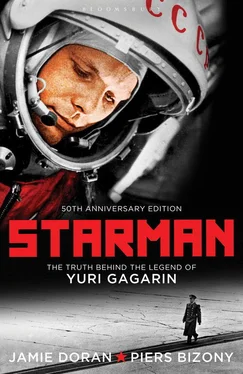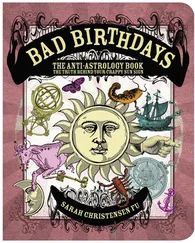Baikonur’s modern launch record is good, but the early years of the complex were dogged by failure. In particular, the six months prior to Vostok’s first manned launch were extremely discouraging. On October 10, 1960, Korolev’s robot probe Mars I reached a paltry 120 kilometres into the sky before falling back to earth like a damp squib. The base blocks of the R-7 booster fired according to plan, but the uppermost interplanetary stage, designed too hurriedly, failed to push the probe clear of the earth’s gravity. Four days later, a second probe fell back in the same way. At the time Nikita Khrushchev was attending a United Nations conference in New York. He had looked forward to boasting about the Mars project, but an urgent coded telegram from Moscow changed his mind. He was most upset.
In mid-October a new prototype rocket, the R-16, was hoisted upright for launch at Baikonur. This was one of Mikhail Yangel’s military machines, designed as a replacement for Korolev’s R-7, which was proving somewhat frisky for space exploration and even worse as a strategic missile. If the Soviets were ever to deploy a truly credible force of ICBMs, they had to find a rocket capable of firing at much shorter notice. The R-7 was fine as it went, but it took at least five hours to fuel and prepare. The problem was its use of liquid oxygen, which was a highly efficient chemical when it was actually burning inside an engine, but would not keep for very long prior to launch. Inevitably, after a few hours it warmed up and turned from liquid to gas. The pressure in the tanks climbed towards bursting point and the accumulating gas had to be vented, then replaced with fresh supercold liquid. The longer an R-7 stood on the pad, the more the greedy creature needed replenishment.
The R-16 was designed to need far less preparation before launch, in keeping with the military’s need for a fast-response missile. It could be fuelled and primed several days, or even weeks, before it was needed, with no loss of oxidizer, because Yangel had disowned supercold liquid oxygen and kerosene in favour of nitric acid and hydrazine. These chemicals could be stored for long periods inside the rocket at normal pressures and temperatures, without venting or leakage. The R-16 could be kept on permanent standby in a secret silo, ready to strike the Americans at a moment’s notice. The only trouble was that its ‘storable’ fuels would not store. They were viciously corrosive and did just what they were not supposed to do – they leaked.
Thwarted by the Mars probe failures in October, Nikita Khrushchev remained quite determined to come up with a bold gesture for the United Nations conference, so he focused on Soviet military superiority. ‘We’re turning out missiles like sausages from a machine!’ he crowed. On his return to Moscow he pressured his Chief of Missile Deployment, Marshal Mitrofan Nedelin, to come up with a tangible demonstration of strength. Khrushchev wanted no damp squibs this time. Nedelin flew to Baikonur straight away to supervise the début launch of Yangel’s R-16 on October 23.
As zero-hour approached, the missile began to drip nitric acid from its base. What does a cosmodrome commander do when a fully fuelled rocket springs a leak? He drains its fuel away carefully and then pumps non-flammable nitrogen through the tanks to get rid of any lingering vapours. Next day he might send in a couple of brave technicians in heavy fire-suits to ‘safe’ the rocket, so that it can be taken down and checked. Instead, Nedelin sent dozens of ground staff to the pad straight away, to see if they could tighten up some valves, stop the leaks, and get the R-16 up in the air. His instructions seemed so insane that the crews were at a loss how to proceed. In the firing blockhouse, the proper thing to do was to reset all the electronic sequencers and disarm them, before they could send any further ignition signals to the rocket. Nedelin ordered the firing sequences to be revised and delayed, but not cancelled. Somehow, a wrong command was transmitted to the R-16’s upper stage. Its engine fired, straight away burning a hole in the top of the stage beneath it. This lower stage exploded, instantly killing everyone on the gantry. With nothing to support it, the upper stage then crashed to the ground, spilling fuel and flame. The new tarmac aprons and roadways around the gantry melted in the heat, then caught fire. Ground staff fleeing for their lives were trapped in the viscous tar as it burned all around them. The conflagration spread for thousands of metres, a wave of fire engulfing everything and everyone in its path. More than 190 people were killed, including Nedelin, perched on his chair near the gantry, as a wall of blazing chemicals swept towards him. [4] Oberg, James, ‘Disaster at the Cosmodrome’, Air & Space Magazine, December 1990, pp. 74–7. For some years Western analysts were confused about the identity of the rocket that blew up. The Nedelin disaster happened to coincide with the early R-7 Mars probe failures, but Nedelin’s R-16 was definitely a military missile, not a space launcher. See also: Joint Publications Research Service-UMA-89-015, June 15, 1989, pp. 34–50.
For thirty years the West knew little of this, although it was apparent from various Intelligence reports that something had gone awry. In particular, an American Discoverer spy satellite photographed Baikonur the day before and the CIA noted with interest the stacking of a new missile. On October 24, the Discoverer in its predetermined orbit overflew the site once again and recorded no gantry and no rocket, just a very large dark smudge despoiling the landscape. The rocket had exploded, but so what? American rockets also blew up from time to time. One had to expect the occasional bad day. The scale of the disaster was not immediately apparent because all news of it was suppressed. All of Soviet Russia was saddened to hear (eventually) that Marshal Nedelin and several other senior missile officers had been killed in an ‘aircraft accident’. Of course the absence of many familiar faces became obvious to thousands of space workers beyond Baikonur, but such unpleasant and difficult matters could be discussed only in private. The sudden disappearance of dozens of young military technicians from Yangel’s squad – most of them just nineteen, twenty, twenty-one years old – was not so immediately apparent, except to their mothers.
Gagarin and his fellow cosmonauts were told that a prototype missile – not one of Sergei Pavlovich’s ‘Little Sevens’ – had blown up and several technicians had been injured. No doubt they knew better, but for the time being they remained closeted from the worst of the horror in their training compound at Star City. In fact the explosion did not greatly delay preparations for Vostok. Surviving ground crews at Baikonur were able to continue their work. The pads, fuelling pipes and blockhouses assigned to the manned mission were not damaged, and few of Korolev’s most important technicians had been actively involved with the R-16.
Then, less than three weeks before the first manned flight, one of the cosmonauts was killed. Valentin Bondarenko was the baby of the group, a fresh-faced lad of twenty-four years. When his turn came to go into the isolation chamber, he handled his assignment very well. His was a fairly long session (fifteen days), to see how he made out. On March 23 he prepared to exit the chamber. They were running a ‘high-altitude’ regime, and the chamber had to be brought up to normal pressure very slowly, or Bondarenko would suffer from the ‘bends’. There was another half-hour to go before the supervising technicians could equalize the pressures and open the hatch. Bondarenko stretched, climbed out of his itchy woollen outer garment and peeled the medical sensor pads from his torso and upper arms with evident relief. He cleaned his irritated skin with pads of cotton daubed in alcohol. Perhaps he tossed the pads aside a little carelessly. One of them landed on the hotplate of the little cooking stove and caught alight. In the confined, oxygen-rich environment of the chamber, the fire spread with terrifying rapidity.
Читать дальше












